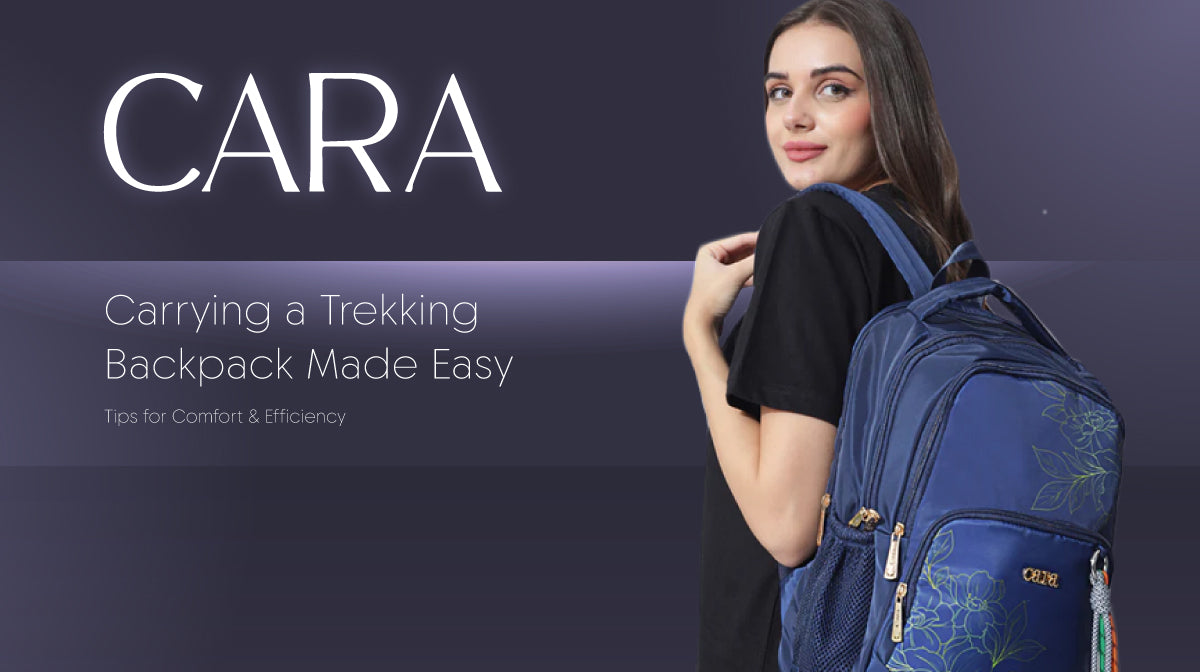
Carrying a Trekking Backpack Made Easy: Tips for Comfort & Efficiency
When you are out hiking on a trail, your trekking pack provides more than just equipment; it is your portable base camp. Carrying everything from food and spare layers to a tent and a sleeping bag. But if you don’t know the correct method of taking it, you could turn your dream hike into a nightmare instead. Painful shoulders, sore hips, and poor posture are issues that many hikers struggle with if their pack is not fitted or appropriately adjusted.
This is why tips for carrying your trekking backpack effortlessly are essential for anyone who is ready to hit the trails, whether you are trekking through the Himalayas or going for a weekend hike in the nearby hills. From how to carry a backpack comfortably to how to adjust a backpack strap for comfort, these tips will help you to balance the weight and apply less strain on your body so that you can trek longer without feeling weighed down.
This guide will cover everything from the proper fit of your pack to how to distribute weight properly, as well as posture tips to help you trek better, not harder.
First Step: Select a Bag that is Perfect for Your Torso

Buying a backpack just because it has multiple pockets will not work. Select a bag that matches your physique. You can start by measuring your torso length, rather than your height or weight. It is the easiest method to fit a hiking backpack.
-
Measure using a measuring tape from the C7 vertebra, which is the base of your neck, to the top of your hip bones.
-
Although backpacks are available in small, medium, and large sizes, some manufacturers have harness systems that can be adjusted to fit your physique.
-
An empty bag can feel very different when loaded, so always test the pack with weight before purchasing.
-
With the majority of the weight held by your hips rather than your shoulders, a well-fitted backpack should fit securely against your back without any gaps.
Read More: Learn about the different types of handbags made for women.
Second Step: Learn How to Buckle Up
Tightening backpack straps until they feel secure is only one step in the process of adjusting them for comfort. The proper order is as follows:
-
Start with loosening all of the straps.
-
Hip Belt First: Place the belt over your hip bones and tighten it just enough to fit without poking in. About 60–70% of the pack's weight should be supported by this.
-
Shoulder Straps Next: To tighten the straps without removing the pack from your hips, pull down and back.
-
Load Lifters: To help raise the pack closer to your body, these tiny straps, which are located above your shoulders, should be angled at a 45-degree angle.
-
Sternum Strap: To balance the load and lessen the weight, clip it across your chest.
Re-adjust regularly during your trek, especially after steep climbs, as your posture and pack balance shift over time.
Third Step: Tips to Balance Your Load
If your pack is weighing down one side or dragging you back, you really have bad backpacking skills. These strategic packing suggestions are the secret to balancing your pack weight for trekking:
-
Water bottles, kitchenware, and food supplies should be kept near your spine and at mid-back level.
-
Bulky things, sleeping bags, and clothing should be placed in the middle.
-
Maps, snacks, and jackets should all be within easy reach without sacrificing the stability of your pack.
-
Avoid placing your water bottles on one side, as this can cause bad posture and back pain due to uneven weight distribution.
-
Consider the components of your backpack as a counterbalance system; they should cooperate to keep you stable and upright over uneven terrain.
Fourth Step: Steps to Lift Your Backpack Safely

It may seem simple, but before you start, everyone knows that bad lifting technique is a common reason of back injury. Use this safer technique rather than swinging your pack up onto one shoulder:
-
Place your backpack on the ground in the upright position.
-
Place one knee through the shoulder straps and grasp the haul loop (top handle).
-
After slipping one arm into a shoulder strap, hold the pack onto your back and slide the other arm into other strap.
-
After it is in position, adjust the straps.
This technique prevents needless twisting actions and protects your back.
Fifth Step: Keep Checking Your Posture While Trekking
Your trek can be ruined by bad posture, even if your gear is well set. Here's how to improve your body alignment and carry a backpack more comfortably:
-
When going uphill, lean slightly forward to counteract the backward drag of your backpack.
-
Keep Your Shoulders Back and Use Your Core to Stay Upright on Level Ground.
-
Use trekking poles to increase stability and disperse weight.
-
Take breaks to stretch every hour, take a moment to relax, stretch your back, and roll your shoulders.
Sixth Step: Use the Compression Straps

Your secret weapon for stability and comfort is a compression strap. When you tighten them, your pack's volume decreases, placing the weight closer to your back and avoiding shifting objects. For optimal stability, always compress from the bottom up.
Seventh Step: Always Wear Comfortable Clothes
Your backpack comfort depends on the clothes and gear you choose.
-
Padded Shoulder Straps: If your bag strap’s pads are thin, consider buying extra pads from the market to prevent shoulder strain.
-
Moisture-wicking shirts: These shirts lessen chafing and stop perspiration.
-
Avoid loose straps: While trekking, flapping straps can cause imbalance.
Eight Step: Adjust the Straps According to the Trek
The perfect fit for your backpack varies depending on the path. To maintain your weight lower on steep inclines, tighten your hip belt and release your shoulder straps a little. To stabilize your center of gravity during descents, do the opposite: tighten the shoulder straps and loosen the hip belt.
Ninth Step: Keep Training Yourself

Begin your training at home if you have never spent hours carrying a fully filled backpack. Before taking on lengthy excursions, try increasing the weight on shorter walks. Before the actual journey, this helps you identify the ideal way to fit a hiking backpack and stretches your muscles.
Avoid These Mistakes
-
Wear the hip belt in mid position, neither too low nor too high.
-
Never avoid load lifters.
-
Never pack too much unnecessary items.
-
Do not carry entire weights on your shoulders; instead, use your complete torso.
-
Not adjusting the straps after rest periods.
You can significantly enhance the efficiency and enjoyment of your walk by avoiding these pitfalls.
Do you know why Duffel Bags are a stylish and spacious pick for every traveler?
Conclusion
It doesn’t need to be a challenge to your endurance while carrying a trekking backpack for a hiking trip. With the right trekking backpack carrying tips, you can turn your hiking adventure from a nightmare to an enjoyable hike. The trick is preparation: getting a proper fit, packing smart, adjusting your straps properly, and keeping good hiking posture.
These strategies will help you cover the distance, feel lighter, and lessen your chance of injury, whether it's a multi-day mountain trek or a short weekend trip. When your rucksack works with your body, instead of against it, each step can feel easier. Think of your trekking backpack as more than just a bag; it is part of your trekking system.
Are you looking for a stylish backpack that adjusts to fit for trekking, offering a comfortable fit and durable material? At Cara Fashion, your outdoor gear should be both fashionable and functional.
Our purpose-built adventure backpacks incorporate smart storage configurations and ergonomically designed straps. So check out our trek-ready backpacks selection and hit the trail with confidence. The mountains feel a little lighter when you look good and feel good.
FAQs
1. How many kgs are ideal for carrying a backpack?
A medium-length journey typically takes four to seven days, while a longer trek may last eight to twelve days. Trekking for a moderate to extended period. The ideal weight range for a backpack is 8–12 kg. Trekkers need to develop the practice of carrying it comfortably. Additionally, you will leave less of an imprint on the mountain if you do this.
2. How to make a backpack hurtless?
To distribute the weight uniformly, ensure that you put on and tighten both straps. Use the waist belts if your bag has them. Some of the weight can be supported lower down thanks to this feature. Your back and neck pain may lessen as a result.
3. How to put a heavy item in a trekking bag?
Pack the heavy items in the area directly next to your back, in the middle and at the top of the backpack, if you want to walk. On the other hand, it is wise to put the weight low and toward the back if you are going skiing.




